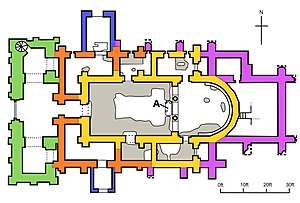Porticus

In this plan of St Mary's Church, Reculver, in north-east Kent, the porticus of the 7th-century church are represented by the extensions to north and south from the main structure, which is in yellow. Other colours represent later additions.
A porticus, in church architecture and archaeology, is usually a small room in a church.[1] Commonly porticus form extensions to the north and south sides of a church, giving the building a cruciform plan.[Fn 1] They may function as chapels, rudimentary transepts or burial-places. For example, Anglo-Saxon kings of Kent were buried in the south porticus at St Augustine's Abbey, with the exception of Eadberht II, who was buried in a similar location in St Mary's Church, Reculver.[3]
This feature of church design originated in the late Roman period and continued to appear in those built on the European continent and, in Anglo-Saxon England, until the 8th century.[4]
References
Footnotes
- ↑ The nominative plural of the fourth-declension, feminine Latin noun "porticus" is "porticūs".[2]
Notes
- ↑ "Glossary of ecclesiastical terms". Archi UK. n.d. Archived from the original on 29 June 2016. Retrieved 28 January 2017.
- ↑ Lewis, C.T.; Short, C., eds. (n.d.). "porticus". A Latin Dictionary. www.perseus.tufts.edu. Archived from the original on 31 January 2016. Retrieved 6 September 2018.
- ↑ Kelly 2008, pp. 78–9.
- ↑ Cherry 1981, p. 168.
Bibliography
- Cherry, B. (1981) [1976], "Ecclesiastical architecture", in Wilson, D.M., The Archaeology of Anglo-Saxon England, Cambridge University Press, pp. 151–200, ISBN 0-521-28390-6
- Kelly, S. (2008), "Reculver Minster and its early charters", in Barrow, J.; Wareham, A., Myth, Rulership, Church and Charters Essays in Honour of Nicholas Brooks, Ashgate, pp. 67–82, ISBN 978-0-7546-5120-8
This article is issued from
Wikipedia.
The text is licensed under Creative Commons - Attribution - Sharealike.
Additional terms may apply for the media files.